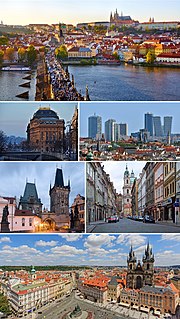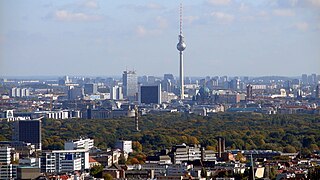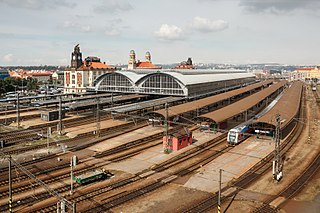| Overview | |
|---|---|
| Service type | Interexpress (IEx) (1986–ca. 1990) Schnellzug (D) (ca. 1990–1993) |
| Status | Replaced by EuroCity |
| Locale | Czechoslovakia / Czech Republic GDR / Germany |
| Predecessor | Progress |
| First service | 1986 |
| Last service | 1993 |
| Successor | EC Porta Bohemica |
| Route | |
| Start | Praha hl.n. |
| End | Berlin-Lichtenberg |
| Service frequency | Daily |
| Train number(s) | IEx 76/77 (1986–1991) D478/479 (1991–1993) |
| Technical | |
| Track gauge | 1,435 mm (4 ft 8 1⁄2 in) |
| Electrification | 15 kV AC, 16.7 Hz (Germany) |
The Primator was an international express train. Introduced in 1986, it ran between Prague, then the capital of Czechoslovakia, and East Berlin, then the capital of the German Democratic Republic (GDR).

Express trains are a form of rail service. Express trains make only a small number of stops, instead of stopping locally. In some cases, trains run express where there is overlapping local train service available, and run local at the tail ends of the line, where there is no supplemental local service. During overnight hours, or other times where it is practical, express trains may become local, but still running to where an express train would terminate.

Prague is the capital and largest city in the Czech Republic, the 14th largest city in the European Union and the historical capital of Bohemia. Situated in the north-west of the country on the Vltava river, the city is home to about 1.3 million people, while its metropolitan area is estimated to have a population of 2.6 million. The city has a temperate climate, with warm summers and chilly winters.

Czechoslovakia, or Czecho-Slovakia, was a sovereign state in Central Europe that existed from October 1918, when it declared its independence from the Austro-Hungarian Empire, until its peaceful dissolution into the Czech Republic and Slovakia on 1 January 1993.
Contents
Following the major political changes that took place in Central Europe in the second half of 1989, Prague became the capital of the Czech Republic, East Berlin was absorbed by Berlin and the GDR by Germany.

The Czech Republic, also known by its short-form name, Czechia, is a landlocked country in Central Europe bordered by Germany to the west, Austria to the south, Slovakia to the east and Poland to the northeast. The Czech Republic covers an area of 78,866 square kilometres (30,450 sq mi) with a mostly temperate continental climate and oceanic climate. It is a unitary parliamentary republic, with 10.6 million inhabitants; its capital and largest city is Prague, with 1.3 million residents. Other major cities are Brno, Ostrava, Olomouc and Pilsen. The Czech Republic is a member of the European Union (EU), NATO, the OECD, the United Nations, the OSCE, and the Council of Europe.

Berlin is the capital and largest city of Germany by both area and population. Its 3,748,148 (2018) inhabitants make it the second most populous city proper of the European Union after London. The city is one of Germany's 16 federal states. It is surrounded by the state of Brandenburg, and contiguous with its capital, Potsdam. The two cities are at the center of the Berlin-Brandenburg capital region, which is, with about six million inhabitants and an area of more than 30,000 km², Germany's third-largest metropolitan region after the Rhine-Ruhr and Rhine-Main regions.

Germany, officially the Federal Republic of Germany, is a country in Central and Western Europe, lying between the Baltic and North Seas to the north, and the Alps, Lake Constance and the High Rhine to the south. It borders Denmark to the north, Poland and the Czech Republic to the east, Austria and Switzerland to the south, France to the southwest, and Luxembourg, Belgium and the Netherlands to the west.
In 1993, under the influence of all of these changes, the Primator was replaced by a new EuroCity train, the Porta Bohemica .

EuroCity, abbreviated as EC, is a cross-border train category within the European inter-city rail network. In contrast to trains allocated to the lower-level "IC" (InterCity) category, EC trains are international services that meet 20 criteria covering comfort, speed, food service, and cleanliness. Each EC train is operated by more than one European Union or Swiss rail company, under a multilateral co-operative arrangement, and all EC trains link important European cities with each other.
The Porta Bohemica is a EuroCity (EC) international express train. Since December 2014 it is operating between Hamburg-Altona and Budapest Keleti.

















